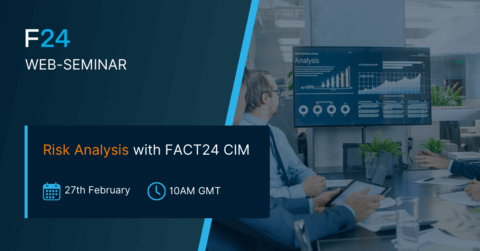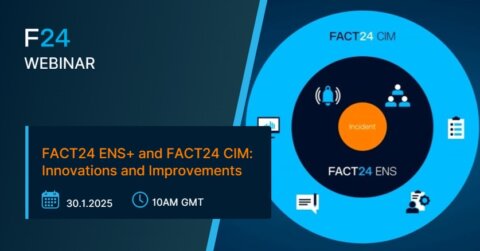IT equipment for alerting and crisis management
Saving you time, budget and nerves
By Dr. Klaus Schäfer, VP Technology – F24 Group

In 2017, companies worldwide spent $124 billion on the security of their information systems. This was an increase of 8.7 percent over the previous year according to a calculation by the analysts at Gartner. But it’s not just IT security spending that is rising. According to Capgemini, updates and additional functionality consumes a quarter of the entire IT budget.
The reason: shorter development cycles and an increasing number of applications. More and more time and resources flow into the operation and maintenance of IT. This means time and money that many companies would rather invest in the further development of their core businesses.
Comfortable SaaS solutions are therefore increasingly replacing traditional licensed software. All companies need is a terminal device of some kind and a good secure Internet connection. The SaaS provider takes care of the rest. This is efficient, flexible and takes the strain off the company’s own IT department, especially in the face of increasing security tasks.
Whether it’s data protection, security updates or new product versions, a SaaS solution client can be blissfully free of all these burdens and embrace the freedom to focus on the real burning issues such as digitalisation, internal requirements or new business ideas. However, above all, SaaS solutions protect budgets and nerves when it comes to business-critical solutions, such as alerting and crisis management systems, which must be available at all times – even in the event of an IT emergency.
Electricity, gas, water, SaaS
But what exactly is SaaS? The abbreviation stands for Software-as-a-Service. In a way, this isn’t anything new. Most people have been using a kind of SaaS solution for many years if they have a private e-mail address at Google or 1&1, run a website with WordPress, work with Salesforce in their business environment, make video calls via GoToMeeting or use collaboration tools such as Slack.
These applications are delivered by using the internet and paid for as part of a subscription or are paid on a usage-basis. The great advantage of SaaS is that clients don’t have to install or maintain the software. The provider guarantees the security and availability of the application.
In principle, the SaaS solution works like buying electricity or water. The provider not only manufactures the product and ensures its quality, by regular updates, security checks and the integration of legal regulations for the software for example, but also creates the conditions for it to be available to the client at all times swiftly and reliably by using powerful servers with high availability.
When and how much of the product is used, however, is the client’s decision. SaaS solutions are invoiced on a usage basis by access and duration or on the basis of monthly flat rates.
The benefits of SaaS: secure, high availability, cost-effective
While SaaS solutions are already widespread in the private sector, companies were cautious at the beginning. In a survey conducted by the Institute for Business Informatics and New Media at the Ludwig Maximilian University in Munich, enterprise clients saw the greatest risk factors in the areas of security and finance. They feared, for example, the lack of availability of a service or the loss of sensitive data as well as hidden costs in the integration or future increases in subscription prices.
However, SaaS solutions have proven their worth and are becoming more and more popular in the private sector based on many positive experiences. They are particularly popular for standard applications that are delivered one-to-many and require little individualisation – e.g. project management apps, content management systems (CMS), programs for financial accounting or customer relationship management (CRM).
The advantage: SaaS customers need neither install nor maintain the software.
Dr. Klaus Schäfer, VP Technology – F24 Group
The advantages of Software-as-a-Service are manifold:
Cost-effective: low investment and low overall cost since no additional hardware and software are required and no additional costs are incurred for maintenance and updating to the latest security, data protection or compliance standards.
User-friendly: fast, straightforward, ready anytime and anywhere via the Internet without time-consuming implementation and therefore independent of a company’s own IT infrastructure even in an IT emergency.
Secure: The provider always keeps the system up to date and ensures the highest possible security through comprehensive control systems.
Flexible: The client decides when and to what extent the system is used. If required, extended functions can be added at any time.
High availability: Independent systems ensure a high level of reliability; a 24/7 availability is usually contractually guaranteed. This means that there are no costs due to system failures.
Gives you peace of mind when you need it most
In particular, the independence from one’s own system is an advantage that makes the SaaS model especially interesting for business-critical applications such as alerting and crisis management systems and ensures increasing demand in this area. In a digitalised world, there is hardly an emergency or crisis that doesn’t affect corporate IT in some way. According to the Allianz Risk Barometer 2019, cyber incidents and business disruptions are among the largest business risks worldwide.
In the event of an attack, the usual communication channels are quickly impaired or even inoperative. An on-premises alarm system or an in-house alarm server may not work when they are most needed. The SaaS solution, on the other hand, is hosted by the provider so it is always ready when disaster strikes, even if the SaaS provider itself is under attack. This is because a good SaaS provider will have a fully redundant system that absolutely ensures the necessary availability.
This is something that would consume vast sums of money if it was tackled via an in-house solution. In addition, the client can rely on the systems being secure and fully legally compliant in the respective area of application.
Trust is a good thing, a provider check is better
The initial reluctance of companies with regards to SaaS was not unjustified. The client must be able to fully trust the provider, especially when it comes to business-critical applications. This means checking a few things very carefully. Does the provider have all the necessary certifications? Do they have competent support personnel? Do they take into account all current regulations, e.g. new data protection laws? In alerting and crisis management for example, contact data (including private data) of service providers, employees and management are usually required for the efficient management of incidents, emergencies and crises. Secure handling of this sensitive data must be guaranteed by the provider. A good way to do this is through ISO/IEC 27001:2013 certification and GDPR-compliant processes and storage.
The future belongs to service
Whether it’s SaaS or some kind of in-house solution, each company needs to make a cost-effective decision. The figures show that the demand for SaaS solutions is growing. Gartner experts expect global SaaS revenues to nearly double to $113.1 billion by 2021 compared to 2017. It is difficult to be precise about the reasons behind this development but, as already mentioned, there are plenty of advantages. What we know for certain is that our clients appreciate the high reliability and flexibility. Since security and crisis management require full-time concentration, no-one has the time, let alone the nerves, to cope with all the knock-on effects of system failures.


